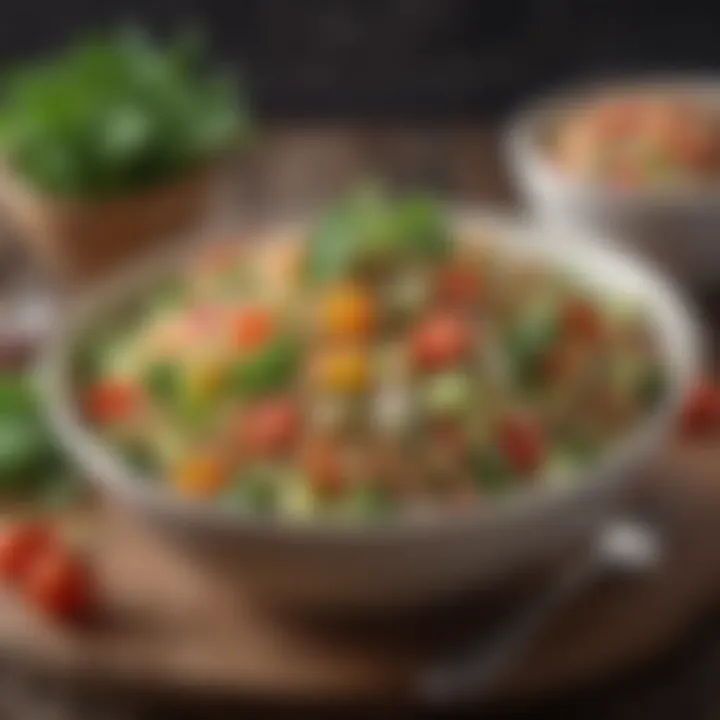Creative Vegetarian Meal Ideas for Every Palate


Intro
Vegetarian cuisine is often misunderstood and underappreciated. This section aims to change that perception by presenting innovative meal ideas that not only cater to diverse tastes but also emphasize nutritional balance. Cooking without meat can unlock an array of flavors and textures while providing significant health benefits. The artistry of vegetarian cooking relies on the careful selection and combination of ingredients.
Within this article, we will explore various vegetarian meal ideas that can inspire home cooks, ranging from simple weeknight dinners to intricate gourmet dishes. Attention will be paid to essential ingredients, techniques, and creative styles, ensuring that every meal is satisfying and enjoyable.
"Vegetarian meals can be both simple and elaborate. It is about how well one can use available ingredients to create a memorable experience."
One of the main focuses will be on the incorporation of seasonal vegetables and grains. By harnessing the full potential of plant-based foods, we can create meals that excite the palate. We will also highlight ways to add depth to dishes through herbs, spices, and various cooking techniques.
In the sections that follow, expect to find:
- Overviews of carefully curated recipes
- Lists of main and optional ingredients
- Practical cooking methods
- Tips for enhancing flavor and presentation
Join us on this culinary journey as we reimagine vegetarian dishes that promise satisfaction, nutrition, and enjoyment.
Intro to Vegetarian Cooking
The rise of vegetarianism is not merely a trend; it signifies a comprehensive lifestyle choice that resonates with individuals across various demographics. It’s essential to recognize the shift towards plant-based diets and how they can contribute to one’s well-being. The benefits are multifaceted, encompassing not only health advantages but also a positive ecological footprint.
Understanding Vegetarianism
Vegetarianism is more than just avoiding meat. It encompasses a range of diets where individuals choose to omit animal products to varying degrees. There are several types of vegetarianism: lacto-vegetarian (dairy included), ovo-vegetarian (eggs included), and vegan (no animal products at all).
This diversity allows for flexibility in meal planning and a broad spectrum of flavors and textures. Understanding these distinctions can help individuals choose a path that aligns with their personal values and health goals.
Adopting a vegetarian lifestyle can be influenced by philosophical beliefs, health considerations, or environmental concerns. The interconnectedness of these factors enriches the vegetarian cooking experience, providing a meaningful context to each meal prepared.
Nutritional Considerations
When embarking on vegetarian cooking, nutritional balance is a paramount consideration. A well-planned vegetarian diet can offer all essential nutrients required for optimal health. Key elements to focus on include:
- Proteins: Essential for muscle repair and immune function. Sources include legumes, nuts, and seeds.
- Iron: Critical for transporting oxygen in the blood. Plant sources like lentils, spinach, and quinoa can be paired with vitamin C-rich foods to enhance absorption.
- Calcium: Important for bone health. Dairy and fortified plant milks are covered here along with leafy green vegetables.
- Vitamin B12: Primarily found in animal products, vegetarians should consider fortified foods or supplements.
- Omega-3 Fatty Acids: Found in walnuts, flaxseeds, and chia seeds, essential for heart health.
Proper meal planning can ensure a vegetarian diet is nutritionally adequate. Thoughtfully selecting ingredients helps to avoid nutrient deficiencies and promotes overall health.
In summary, the introduction to vegetarian cooking involves understanding the philosophy behind vegetarianism and paying attention to nutritional needs. This conscious approach to cooking allows for a robust culinary exploration, ultimately enriching the meal experience.
Key Ingredients for Vegetarian Meals
When we talk about vegetarian cooking, the choice of ingredients plays a crucial role. Selecting the right combination not only enhances flavors but also ensures nutritional balance. The ingredients must meet the diverse dietary needs while contributing to a satisfying culinary experience. This section outlines the key ingredients essential for creating innovative vegetarian meals.
Fruits and Vegetables
Fruits and vegetables form the foundation of any vegetarian diet. They provide essential vitamins, minerals, and fibers that are important for overall health. Using a wide variety of colors and types can enhance both nutrition and aesthetic appeal.
Some benefits include:
- Rich in Nutrients: Fruits and vegetables offer antioxidants, which help combat oxidative stress.
- Versatile Usage: They can be eaten raw, cooked, roasted, or blended.
- Flavor Variety: Different fruits and vegetables can add sweetness, bitterness, or acidity, creating diverse taste profiles in dishes.
For example, using seasonal vegetables like zucchini in summer or root vegetables like carrots in winter can help reflect seasonal changes in your meals.
Legumes and Pulses
Legumes and pulses provide an excellent source of protein for those following a vegetarian diet. They include beans, lentils, peas, and chickpeas, which are not only rich in protein but also high in fiber and low in fat. Incorporating these ingredients can significantly boost the nutritional content of meals.
Considerations when using legumes include:
- Cooked from Scratch: Soaking dry legumes and cooking them can further enhance digestibility.
- Culinary Variety: Legumes can be mashed into spreads, added to salads, or made into curries and soups.
- Sustainable Foods: They require fewer resources to grow compared to animal proteins.
Grains and Cereals
Grains and cereals are another vital component of vegetarian meals. They serve as a primary source of carbohydrates, providing energy needed for daily activities. Whole grains, such as quinoa, brown rice, and barley, are particularly beneficial due to their higher fiber content.


Key points about grains include:
- Nutritional Density: Whole grains retain more nutrients compared to refined grains.
- Variety of Flavors: Different grains can change a meal's texture and flavor, making it more interesting.
- Meal Base: Grains can act as a base for various dishes, like salads and bowls, complementing other ingredients.
Nuts and Seeds
Nuts and seeds bring healthy fats, proteins, and added texture to vegetarian meals. Common options include almonds, walnuts, chia seeds, and flaxseeds. They are nutrient-dense and can contribute significantly to heart health.
Benefits of including nuts and seeds are:
- Source of Omega-3 Fatty Acids: Particularly relevant for brain health.
- Snacking Power: Nuts and seeds can serve as healthy snacks or toppings.
- Culinary Enhancement: Toasted nuts or seeds can enhance both flavor and visual appeal in several dishes.
Simple Vegetarian Meal Ideas
In this section, we explore the realm of simple vegetarian meal ideas. These meals are characterized by their ease of preparation and ability to fit into busy lifestyles while still providing nutritious value. The emphasis on simplicity does not compromise the rich flavors and health benefits associated with vegetarian cuisine.
Simple vegetarian meals are not just quick to prepare; they also offer versatility and adaptability. Whether you are a novice cook or an experienced chef, these meal ideas can help enhance your cooking repertoire. By focusing on basic, yet flavorful ingredients, these meals can cater to various taste preferences and dietary needs.
When planning simple vegetarian meals, it is essential to consider nutritional balance. Diverse ingredients such as vegetables, legumes, grains, and healthy fats can create meals that are not only satisfying but also beneficial to your overall health. Minimal cooking time means you can enjoy your food without significant investment of time.
"Simplicity in preparation allows for creativity in flavor, making vegetarian meals both enjoyable and healthy."
Quick Salads
Quick salads serve as a beautiful introduction to simple vegetarian meals. They can be customized using a wide variety of ingredients based on what is in season or available at home. Typically, a quick salad can be assembled in less than 15 minutes.
Basic elements of a quick salad include greens like lettuce or spinach, along with added ingredients such as cherry tomatoes, cucumbers, and bell peppers. To amp up the nutrition, consider adding beans, nuts, or seeds.
Dressing can also play a significant role in transforming a straightforward salad into a flavorful dish. An olive oil and balsamic vinegar combination can bring freshness without overwhelming the primary ingredients. Preparing these salads allows for a quick, healthy, and satisfying meal option.
Vegetable Stir-fries
Vegetable stir-fries are another fantastic choice connecting simplicity and nutrition. They require minimal cooking utensils and are adaptable based on available vegetables. This method promotes quick cooking over high heat, preserving nutrients and flavors.
Basic stir-fry ingredients include a variety of vegetables like broccoli, carrots, and bell peppers. These vegetables can be paired with tofu or tempeh for protein. Soy sauce, garlic, and ginger can enhance the flavors with little effort.
A stir-fry not only showcases the natural colors of vegetables but also allows for creative pairing based on personal preferences. Quick, healthy, and delightful, stir-fries can be served over rice or quinoa for a wholesome meal.
Pasta Dishes
Pasta serves as a comfort food that fits well into simple vegetarian meal ideas. Whole-grain pasta offers additional fiber, making it a healthier choice. Combining pasta with an array of vegetables creates a balanced dish.
Consider tossing cooked pasta with sautéed zucchini, spinach, and mushrooms. Add a drizzle of olive oil and a sprinkle of parmesan cheese to enhance the taste, or go for a vegan option by omitting cheese.
This meal option is satisfying and high in carbohydrates, serving as an energy-dense food that can be enjoyed on busy weeknights.
Soups and Stews
Soups and stews represent another simple yet fulfilling aspect of vegetarian meals that emphasizes comfort during colder months. They are usually made by combining broth or water with a variety of vegetables, legumes, and grains.
A simple vegetable soup can include onions, carrots, and celery, slowly simmered in vegetable broth. Legumes, such as lentils or chickpeas, can be added for heartiness. This method allows for the layering of flavors, leading to a rich and complex dish.
Soups and stews can also be made in larger quantities, making them ideal for batch cooking. Extra servings can be stored and reheated easily, thus providing quick meal options throughout the week.
In summary, simple vegetarian meal ideas offer a way to create nutritious and delightful meals that can be prepared quickly. This encourages individuals to embrace vegetarian cooking without overwhelming themselves. The ideas presented emphasize the importance of balancing nutrition with flavor, making vegetarian dishes enjoyable for everyone.
Gourmet Vegetarian Meal Ideas
Gourmet vegetarian meal ideas elevate the experience of plant-based cooking. They allow home cooks to explore complex flavors, sophisticated presentations, and inventive techniques. Cooking vegetarian gourmet is about more than just avoiding meat; it focuses on creating a memorable dining experience. By using high-quality ingredients and thoughtful combinations, these dishes can satisfy discerning palates while still embracing the principles of vegetarianism.
Furthermore, this section showcases how vegetarian meals can fit into fine dining or special occasions without sacrificing taste or presentation.
Stuffed Vegetables


Stuffed vegetables are a versatile and nourishing option. They serve as vessels to combine various flavors and textures, making them appealing to both the eye and the palate. Common choices for stuffing include bell peppers, zucchini, and eggplant. These vegetables have the ability to hold fillings well, absorbing additional flavors during the cooking process.
Filling Options:
- Quinoa
- Black beans
- Rice
- Lentils
- Nuts and seeds
- Herbs and spices
When creating a stuffing, it is essential to balance flavors. For instance, combining hearty grains with fresh herbs can create depth. Consider whether to bake or grill the stuffed vegetables. Both methods offer different outcomes. Baking often results in a softer texture, while grilling imparts a smoky flavor.
Vegetable Risotto
Vegetable risotto is an excellent way to showcase the versatility of grains. Arborio rice, the primary ingredient of risotto, becomes creamy and rich when cooked slowly in broth. This method encourages layering flavors.
When preparing vegetable risotto, a base of onions and garlic forms the foundation. From there, seasonal vegetables can take center stage, such as
- Asparagus
- Mushrooms
- Spinach
- Peas
The key to a successful risotto lies in patience. Stirring frequently allows the rice to absorb the broth gradually, releasing its starch content and creating a velvety texture. Finish with a touch of cheese or nutritional yeast for richness, enhancing the dish's flavor profile.
Grilled Dishes
Grilling adds a unique depth of flavor to vegetarian meals. When done correctly, it can highlight the natural sweetness of vegetables while providing a satisfying char. Various vegetables can be grilled, including:
- Corn
- Eggplant
- Peppers
- Pineapple
- Zucchini
Marinating vegetables before grilling can significantly enhance flavor. Simple mixtures of olive oil, lemon juice, garlic, and herbs can add much-needed zest. Once grilled, these vegetables can be served as is, or incorporated into salads or sandwiches.
In summary, gourmet vegetarian meal ideas offer innovative ways to enjoy vegetarian cuisine. Stuffed vegetables, risotto, and grilled dishes provide a rich array of flavors and textures. They allow both creativity and culinary skill to shine, offering an exceptional experience for all diners.
International Vegetarian Cuisines
Exploring international vegetarian cuisines is essential in understanding the vast potential of plant-based meals. This section brings together diverse culinary traditions that emphasize the use of fresh, seasonal ingredients. By highlighting the cultural backdrop and flavor profiles, readers can appreciate the significance of vegetarianism across the globe. Such cuisines not only offer health benefits but also reflect sustainable practices that resonate with many today. The focus on international dishes can inspire creativity and broaden the culinary repertoire for anyone interested in integrating more vegetarian meals into their diet.
Mediterranean Flavors
Mediterranean cuisine is a treasure trove for vegetarian options. With staples such as olives, tomatoes, and legumes, this region's culinary heritage provides a robust foundation for healthy dishes. Ingredients like feta cheese and fresh herbs elevate flavors while maintaining simplicity. Traditional meals often include dishes like moussaka, a layered eggplant dish, or falafel, made from ground chickpeas and spices, showcasing the region's plant-based abundance. The emphasis on olive oil as a primary fat source also contributes heart-healthy benefits. Incorporating Mediterranean flavors into everyday cooking can lead to both nutritious and satisfying meals.
Asian Inspirations
Asian vegetarian cooking offers a rich tapestry of tastes and textures. Whether it’s the bright flavors of Thai cuisine or the comforting warmth of Japanese miso soup, there are numerous ways to explore this culinary world. In India, vegetarianism is deeply rooted in cultural and religious practices. Dishes like chana masala, made with chickpeas, and palak paneer, a spinach and cottage cheese preparation, exemplify the diversity of flavors in Indian cuisine. Meanwhile, Asian-style stir-fries allow for quick preparation, catering to busy lifestyles without compromising nutrition. Embracing these Asian inspirations can transform simple ingredients into vibrant meals.
South American Traditions
South America boasts a unique approach to vegetarian dishes, often incorporating native ingredients like quinoa, corn, and various beans. Recipes such as arepas, made from corn dough, and cuzco-style soup, featuring a mix of vegetables, showcase traditional methods of utilizing local produce. These meals highlight the region's heritage while offering versatile options for modern cooking. Additionally, dishes like empanadas can easily be adapted to include various vegetarian fillings, providing a delightful blend of flavors and textures.
Indian Vegetarian Dishes
Indian cuisine stands out for its extensive use of spices and herbs, making it inherently rich for vegetarians. Staples like lentils, chickpeas, and various vegetables feature prominently. Dishes such as dal, a lentil soup, and biryani, flavored rice with vegetables, capture the essence of the country's culinary artistry. Vegetarianism in India is diverse and often regional; each state has its unique spin on common ingredients. By exploring Indian vegetarian dishes, one can discover a flavorful world that emphasizes balance and nutrition in every meal.
Nutritional Benefits of Vegetarian Meals
The significance of understanding the nutritional benefits of vegetarian meals cannot be overlooked. In today's health-conscious world, many individuals are drawn to plant-based diets for various reasons, including health, environmental sustainability, and ethical considerations. Vegetarian meals are not only rich in flavors but also packed with essential nutrients. This section highlights the key benefits and elements related to vegetarian nutrition, emphasizing their relevance for anyone interested in improving overall health through diet.
Health Benefits
Vegetarian diets offer numerous health advantages. Numerous studies suggest that a well-balanced vegetarian diet can reduce the risk of chronic diseases. Common health benefits include:
- Lowered risk of heart disease: A vegetarian diet often features higher fiber content and lower saturated fats, which can help improve heart health.
- Weight management: Many plant-based foods are lower in calories, making it easier to maintain a healthy weight.
- Improved digestion: Increased fiber from fruits, vegetables, and whole grains aids in digestion and promotes gut health.
- Reduced diabetes risk: Some research indicates that vegetarians have a lower incidence of type 2 diabetes due to better weight control and dietary choices.
A vegetarian diet demonstrates advantages for longevity. The Mediterranean diet, which is plant-based, is often associated with a longer lifespan. Plant-rich diets provide a plethora of vitamins and minerals vital for maintaining bodily functions.
"A whole-food, plant-based diet can be powerful in preventing and managing chronic illnesses."
Environmental Impact


Another critical aspect of the nutritional benefits of vegetarian meals is their positive impact on the environment. The production of plant-based foods generally requires fewer resources than animal-based foods. It means lower greenhouse gas emissions, less water usage, and decreased land requirements. Here are some essential considerations regarding environmental benefits:
- Reduced carbon footprint: Shifting to a vegetarian diet can lead to significant reductions in an individual's carbon footprint, as livestock farming contributes heavily to greenhouse gas emissions.
- Water conservation: Producing vegetables and grains usually uses less water compared to animal farming, conserving this vital resource.
- Biodiversity preservation: With less reliance on livestock, vegetarian diets contribute to the preservation of natural habitats.
In sum, embracing vegetarian meals not only provides substantial health benefits but also promotes a more sustainable lifestyle. This pursuit of wellness at both the individual and planetary level underscores the value of dietary choices.
Meal Planning and Preparation Tips
Effective meal planning is critical for creating satisfying vegetarian meals. This process allows cooks to streamline their shopping, enhance their kitchen organization, and avoid food waste. Furthermore, it aids in maintaining a balanced diet by ensuring that meals contain diverse nutrients. A strategic approach to planning makes it easier to incorporate various ingredients and flavors, elevating the cooking experience.
Creating a Balanced Plate
A balanced plate is essential for nutritional health. It involves incorporating various food groups into meals to ensure adequate intake of vital nutrients. For vegetarian diets, it is important to consider the following components:
- Fruits and Vegetables: Aim for a colorful variety. They provide essential vitamins and minerals, as well as dietary fiber.
- Proteins: Include legumes, beans, tofu, or tempeh as primary sources of protein. They help in muscle repair and overall health.
- Whole Grains: Foods like quinoa, brown rice, or whole-wheat pasta should be considered. They supply energy and fiber.
- Healthy Fats: Incorporate avocados, nuts, or olive oil to enhance the flavor and nutritional profile of meals.
This method not only ensures that all food groups are represented but also promotes visual appeal on the plate, making meals more inviting.
Batch Cooking Strategies
Batch cooking is a practical approach to meal preparation. It saves time and ensures that healthy meals are always on hand. When embracing batch cooking, consider the following strategies:
- Choose Versatile Recipes: Prepare both simple and complex dishes that can be reused throughout the week. For instance, a large pot of vegetable soup can be portioned and stored for quick lunches or dinners.
- Use Appropriate Storage Containers: Invest in high-quality containers that can safely store food. Glass or BPA-free plastic are great options for holding various meal components.
- Label and Date Everything: Keeping track of when food was prepared allows for effective rotation and minimizes spoilage.
- Freeze Extra Portions: Many dishes freeze well and can be used later. Consider freezing sauces, grains, or full meals for later enjoyment.
Batch cooking not only simplifies meal prep but also supports a consistent vegetarian lifestyle.
"Meal planning aligns your cooking efforts with your nutritional goals, making each meal a deliberate choice rather than an afterthought."
By following these planning and preparation strategies, any cook can navigate the world of vegetarian meals with ease and confidence, ensuring that their approach to nutrition is both enjoyable and fulfilling.
Creative Cooking Techniques
Creative cooking techniques play a significant role in vegetarian meal preparation. They not only enhance the flavors and textures of plant-based ingredients but also allow for greater variety in dishes. Innovation in cooking methods can make a simple meal extraordinary. This section explores two pivotal techniques: fermentation and plating, helping to elevate vegetarian meals.
Fermentation and Preservation
Fermentation is an ancient method used across cultures to enhance food. For vegetarians, fermented foods offer numerous benefits. These include improved gut health, as the probiotics found in fermented items promote a healthy digestive system. Common fermented vegetarian foods include kimchi, sauerkraut, and tempeh.
Preservation is another significant aspect. By fermenting vegetables, such as carrots or cabbage, one can extend their shelf life significantly. This not only reduces food waste but also enables home cooks to enjoy seasonal produce throughout the year.
Benefits of Fermentation
- Enhanced Nutritional Value: Fermentation can boost the bioavailability of vitamins and minerals.
- Flavor Complexity: It adds a unique tanginess and depth to dishes.
- Versatility: Fermented ingredients can be used in various recipes, from salads to main courses.
Creative Plating Ideas
Plating is as much about aesthetics as it is about flavor. The way food is presented can influence how it is perceived. Creative plating can transform an ordinary dish into a culinary work of art. To enhance visual appeal, consider the following approaches:
- Color Contrast: Use vibrant vegetables to create a colorful plate. For example, pairing purple cabbage with yellow squash can make a dish pop visually.
- Layering: Arrange ingredients in layers rather than mixing them. This showcases the individual components, making the dish more interesting.
- Height and Dimension: Creating height on the plate can add an element of surprise. Stack roasted vegetables or grains to add an inviting visual texture.
"A well-plated meal speaks to the care of the chef, inviting diners to indulge in the culinary experience."
In summary, embracing fermentation and innovative plating techniques can significantly enhance the appeal and nutritional profile of vegetarian meals. These methods not only celebrate the ingredients but also invite a more thoughtful dining experience.
Epilogue
The exploration of vegetarian cooking is not limited to flavor alone but factors in the broader implications on health and the environment. By opting for plant-based nutrition, individuals can enhance their overall well-being, potentially decreasing the risk of chronic diseases. Furthermore, a vegetarian diet often offers a lower carbon footprint, addressing the pressing concerns surrounding climate change.
Importantly, meal planning and preparation strategies discussed in prior sections can demystify vegetarian cooking for those who may feel overwhelmed by the idea of a meatless life. Batch cooking, for instance, not only saves time but reduces food waste, making it an accessible strategy for busy kitchens.
"Eating vegetarian is not just about what you don’t eat. It's about exploring what you can create with vibrant and nutritious ingredients."
As the world moves towards more sustainable food systems, the relevance of innovative vegetarian meals cannot be understated. They become a centerpiece for conversation, allowing culinary creativity to flourish. Such meals also foster a deeper connection to the ingredients themselves, offering insights into where food comes from and how it contributes to one’s health.
Ultimately, the ideas presented here aim to inspire all types of home cooks—from beginners trying their first vegetable stir-fry to seasoned chefs delving into global dishes. Embracing creativity in the kitchen opens doors to endless possibilities. The journey of vegetarian cooking is both an adventure and a commitment to a healthier lifestyle. And as demonstrated throughout this article, the options are as vast as the culinary world itself.
Final Thoughts on Vegetarian Meals
Vegetarian meals are more than sustenance; they represent a shift towards mindful eating. Adopting a vegetarian diet can be life-changing. It's important to recognize that each dish can highlight seasonal ingredients and regional flavors. This approach encourages culinary diversity and fosters a deeper appreciation for different cuisines.
Preparing wholesome vegetarian meals need not be intimidating. With regular practice and exploration, one can master various cooking techniques while staying attuned to nutritional balance. Creativity in the kitchen is key to transforming simple ingredients into memorable dishes.







